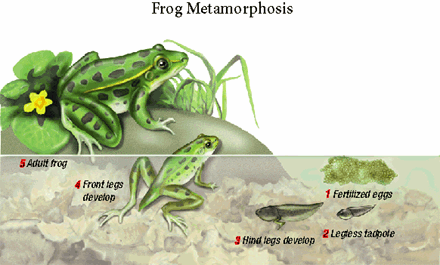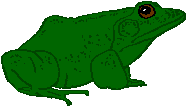

The Egg
Frogs lay their eggs in water or wet places. A floating clump of eggs
is called frog spawn.
The large and slippery mass of eggs are too big to be eaten. This is
nature's way of protecting them. But, the smaller clumps of eggs will be
eaten by the creatures living near or in the pond.
The egg begins as a single cell. Several thousand are
sometimes laid at once. It becomes surrounded by a jellylike covering, which
protects the egg. The female may or may not stay with the eggs to take care of
the young after she has laid them. The egg slowly develops. But, only a few
develop into adults. Ducks, fish, insects, and other water creatures eat
the eggs.
The Cell Splits
The single cell in the egg eventually splits into two. These two split
making four cells, and so on. Eventually, there are many cells in the egg.
The Embryo
The mass of cells in the egg come to form an embryo. Organs and gills begin
to form, and in the meantime, the embryo lives off of its internal yolk. This
supplies it with nutrients for 21 days. Then . . .
The Tadpole

After its 21 day development period, the embryo leaves its jelly shell, and
attaches itself to a weed in the water. This quickly becomes a tadpole, a baby
frog. The tadpoles grow until they are big enough to break free into
the water. This can take from 3 days to 3 weeks, depending on what kind of
frog they will become. They eat very small plants that stick to larger
plants in the water. These tiny plants are called algae. The
tadpole has a long tail, and lives in the water. It is extremely vulnerable, and
must rely on its camouflage to protect it.
The
tadpole has a long tail, and lives in the water. It is extremely vulnerable, and
must rely on its camouflage to protect it. The tadpoles also face danger
by being eaten by other water animals. Sometimes the pond dries up. As a
result the tadpoles die.
The Tadpole Begins To Change
After about five weeks, the tadpole begins to change. It starts to grow hind
legs, which are soon followed with forelegs. Behind their heads
bulges appear where their front legs are growing. Their tails become
smaller. Lungs begin to develop,
preparing the frog for its life on land. Now and then, they wiggle
to the surface to breathe in air. The tail becomes larger and makes it
now possible for the tadpole to swim around and catch food. They eat
plants and decaying animal matter. Some tadpoles eat frogs eggs and other
tadpoles.
Almost There . . .
Over time, the tadpole becomes even more froglike. They have shed
their skin and lips. Its mouth widens, and it
loses its horny jaws. The tail becomes much smaller, and the legs grow. The
lungs are almost functioning at this point.
The Frog

Eleven weeks after the egg was laid, a fully developed frog with lungs,
legs, and no tail emerges from the water. This frog will live mostly on land,
with occasional swims. The tiny frogs begin to eat insects and worms. Eventually, it will find a mate. The way this is done
varies depending on the species. The female lays the eggs, the male fertilizes
them, and the whole process begins again.
Another Diagram
of the life cycle of a frog- Use your back button if you go there.







